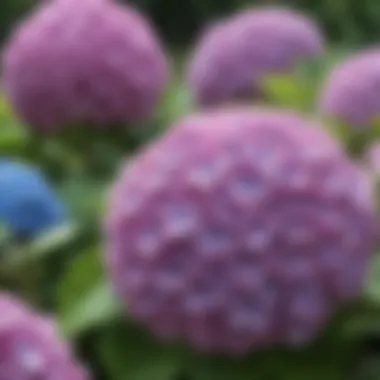Mastering the Art of Continuous Blooming Hydrangeas


Intro
Continuous blooming hydrangeas are a captivating group of plants that have gained popularity among gardeners and landscape designers alike. Unlike their traditional counterparts that have specific blooming seasons, these hydrangeas offer a remarkable bloom throughout a significant part of the year. This continuous display of their large, showy flowers enhances any garden landscape, making them a preferred choice for many.
In this article, we will explore the specific characteristics, cultivation requirements, and care tips for these hydrangeas. Understanding their unique traits will allow gardeners to harness their beauty effectively, contributing to a vibrant garden space.
Key Points to Discuss
- Characteristics of Continuous Blooming Hydrangeas: What sets them apart from other varieties.
- Types of Continuous Blooming Hydrangeas: A look at various hybrids and their specific needs.
- Optimal Growing Conditions: Essential factors for healthy growth.
- Cultivation and Care: Practical advice for maintenance and troubleshooting.
- Landscaping Benefits: How they can transform garden design.
This exploration aims to equip gardeners and landscaping enthusiasts with the knowledge necessary to cultivate these remarkable plants. Continuous blooming hydrangeas are not just visually appealing; they also offer insight into advanced gardening practices and environmental adaptability.
Preamble to Continuous Blooming Hydrangeas
Continuous blooming hydrangeas represent a significant advancement in horticulture, offering an extended flowering period that enhances any garden. These plants are not only visually pleasing but also cater to the diverse needs of gardeners seeking resilient and adaptable flora. Understanding this type of hydrangea can lead to both aesthetic and practical benefits in landscaping and gardening.
Defining Continuous Blooming
Continuous blooming refers to the unique trait of certain hydrangea varieties that bloom repeatedly throughout the growing season. This characteristic stands in contrast to traditional hydrangeas, which typically produce flowers on a set cycle. Planting continuous blooming hydrangeas, means that garden enthusiasts can enjoy ongoing color and beauty from spring through fall, making them an invaluable addition to any garden layout.
These hydrangeas often showcase a wide palette of colors and shapes. For example, some varieties might start with vibrant blue flowers, transitioning to softer hues as the season progresses. The ability of continuous blooming hydrangeas to adapt their appearance based on environmental factors further emphasizes their appeal among gardeners.
Importance in Gardening
The importance of continuous blooming hydrangeas in gardening cannot be overstated. First, they offer decorators and homeowners an opportunity to fill spaces with lasting beauty. This continuous flower production can significantly enhance garden aesthetics, making landscapes more vibrant and inviting. Adding these plants can also contribute to a more engaging environment for local wildlife, such as pollinators like butterflies and bees.
Types of Continuous Blooming Hydrangeas
The classification of continuous blooming hydrangeas is essential for gardeners aiming to enhance their landscapes with versatile and resilient plants. These varieties are noted for their impressive floral displays throughout the growing season, thus offering extended beauty and interest in gardens. Knowing the specific types can help gardeners make informed choices based on personal preferences as well as environmental conditions. Each type possesses unique characteristics in terms of size, color, and growth habits, which can drastically affect garden aesthetics and maintenance requirements.
Hydrangea macrophylla
Hydrangea macrophylla, commonly known as the bigleaf hydrangea, is one of the most popular types of continuous blooming hydrangeas. Its striking blooms range in color from blue to pink, depending on the pH of the soil where it is planted. The flowers of this species appear in large clusters that can create a dramatic effect in any landscape.
This type typically blooms from late spring to fall, providing a long flowering period. Gardeners appreciate its adaptability and the potential for color changes through the season, depending on nutrient availability. It also thrives in partially shaded areas, making it suitable for many garden structures.
In addition to aesthetic appeal, Hydrangea macrophylla often requires regular care. Pruning should be done carefully to encourage healthy growth without affecting its blooming cycle. The use of specific soil amendments can also assist in managing bloom color, allowing gardeners to experiment with hues that best fit their design goals.
Hydrangea paniculata
Another noteworthy type is Hydrangea paniculata, or the panicle hydrangea. This variety is known for its upright growth habit and large, conical flower clusters. The blooms start off creamy white and later develop shades of pink as the season progresses. This transformation in color adds visual interest throughout the flowering period.
Paniculata varieties are notably more tolerant of sun exposure compared to other hydrangeas. They can endure full sun environments, provided they receive adequate moisture. This makes them an excellent choice for garden areas where light is abundant.
Moreover, Hydrangea paniculata is generally less susceptible to winter damage. The plant flowers on new wood, which means it can survive occasional harsh winters and still produce blooms in the following season. This reliability makes it a favorite among gardeners seeking low-maintenance options.
Hydrangea quercifolia
Hydrangea quercifolia, known as oakleaf hydrangea, is distinct for its unique foliage and stunning blooms. The leaves are shaped similarly to those of oak trees, providing an interesting texture to the garden. During summer, the plant showcases cone-shaped flowers that begin as white and develop into rich pink tones as they mature.
Beyond their floral display, oakleaf hydrangeas contribute to the seasonal interest even after blooming. Their leaves turn vibrant shades of red and orange in the fall, capturing attention long after the flowers have faded. This multi-season appeal is a significant advantage in landscape design.
Oakleaf hydrangeas prefer slightly acidic soils, and they thrive in well-drained locations with partial shade. Like other types, they entail some maintenance, including pruning to maintain shape and remove any dead wood. Overall, their adaptability and visual appeal make them a noteworthy option for many garden settings.
Optimal Growing Conditions
To cultivate continuous blooming hydrangeas, understanding optimal growing conditions is essential. These conditions directly influence the plant's health and its ability to flourish. The right environmental factors determine whether these hydrangeas will exhibit lush blooms or struggle to survive. Key elements include soil composition, light exposure, and watering requirements. Each of these factors is interconnected, contributing to the overall well-being of the plant.


Soil Requirements
Soil forms the foundation for any garden, and for continuous blooming hydrangeas, it should be well-draining yet moisture-retentive. A loamy soil mixed with organic matter is ideal. This composition helps retain enough water while allowing excess moisture to escape, preventing root rot. The pH level is also a critical factor. Hydrangeas thrive in slightly acidic to neutral soil (pH 5.5 to 7.0).
- Tips for soil enhancement:
- Incorporate peat moss or compost to improve structure and nutrient levels.
- Regularly check the soil pH. This can be done easily with a pH testing kit.
Light Exposure
Light exposure plays a significant role in the blooming cycle of hydrangeas. Most continuous blooming varieties prefer partial shade, especially during the hottest hours of the day. Too much direct sunlight can scorch the leaves and inhibit flowering. However, inadequate light can lead to weak, leggy growth. Ideally, hydrangeas should receive at least four to six hours of sunlight daily, with some afternoon shade.
Proper light exposure ensures that hydrangeas can photosynthesize effectively, promoting healthy growth and abundant blooms.
- Light placement strategies:
- Situate hydrangeas where they receive morning sun and afternoon shade if possible.
- Use taller plants or structures to provide shade during harsh midday hours.
Watering Needs
Hydrangeas require consistent moisture but dislike being waterlogged. The watering needs vary with the environment and the season. During hot summers, daily watering may be necessary, while in cooler months, reduce frequency. An easy way to gauge if your hydrangea needs water is to check the top inch of soil. If it feels dry, it is time to water.
- Effective watering practices:
- Water deeply and thoroughly to encourage deep root growth.
- Consider using mulch to retain soil moisture and regulate temperature.
By understanding these growing conditions—soil, light, and water—gardeners can cultivate thriving continuous blooming hydrangeas, bringing beauty to their landscapes all season long.
Planting Techniques
The successful cultivation of continuous blooming hydrangeas relies significantly on effective planting techniques. These techniques hold critical importance as they establish the foundation for healthy growth and development. Proper site selection, adequate spacing, and timely planting are all essential factors that can influence the longevity and vigor of these plants. A well-planned planting approach prevents common pitfalls such as diseases and stunted growth. By understanding these techniques, gardeners can ensure that their hydrangeas thrive and produce a stunning display throughout the seasons.
Site Selection
Choosing the right site for planting continuous blooming hydrangeas is crucial. Sunlight exposure plays a key role in their overall health. These plants prefer a location that receives morning sun and afternoon shade. This prevents leaf scorch while still allowing enough light for blooming. Additionally, it is important to ensure proper drainage in the selected site. Hydrangeas do not tolerate waterlogged soil, which can lead to root rot.
Some factors to consider when selecting a site include:
- Soil type: Aim for well-draining soil that retains adequate moisture.
- Proximity to structures: Avoid planting too close to walls or fences that may block natural light.
- Wind exposure: Sites that are sheltered from strong winds will protect the delicate blooms.
Taking the time to carefully choose the right site maximizes the potential for lush, continuous blooming.
Spacing Considerations
Proper spacing between plants is another important factor in planting continuous blooming hydrangeas. Adequate spacing allows for air circulation, which reduces the likelihood of fungal diseases. Each variety may have different spacing requirements, but generally, you should aim to space them about 3 to 5 feet apart. This ensures that they have plenty of room to spread and grow without competing for nutrients.
Key points regarding spacing include:
- Allowing growth: Healthy hydrangeas can reach wide, bushy sizes, so consider their mature size when spacing.
- Accessibility: Proper spacing gives you the ability to care for the plants without difficulty, including pruning and deadheading.
- Aesthetic balance: Thoughtful spacing contributes to a more pleasing visual arrangement in the garden.
Together, these considerations will influence the aesthetic and health of the hydrangeas.
Timing for Planting
The timing of planting is just as important as the site selection and spacing. Spring and fall are the two optimal seasons for planting continuous blooming hydrangeas. In the spring, soil temperatures are conducive for root development, while fall planting gives the plants a head start before winter dormancy.
Guidelines for planting include:
- Timing: In cooler climates, aim to plant in late spring after the last frost to encourage healthy growth.
- Weather conditions: Ideal conditions include overcast days or light rain, which reduces transplant shock.
- Monitoring soil temperature: Ensure the soil has warmed adequately in spring before planting.


By focusing on these timing considerations, gardeners can foster strong root establishment and enhance the overall health of their hydrangeas.
Proper planting techniques work as a basis for the flourishing of continuous blooming hydrangeas. They are an investment in the beauty and longevity of your garden.
Maintenance and Care
Caring for continuous blooming hydrangeas is vital for ensuring these plants thrive and exhibit their full beauty throughout the growing season. Proper maintenance and care not only promote healthy growth but also enhance floral display. Gardeners must pay attention to several aspects, including pruning, fertilization, and pest management. Each of these categories plays a crucial role in sustaining the health of the plants and keeping their blooms vibrant.
Pruning Strategies
Pruning is an essential activity that influences the growth patterns of hydrangeas. Proper pruning enhances bloom production and shapes the plant. Different types of hydrangeas require distinct pruning approaches. For instance, Hydrangea macrophylla blooms on old wood and ought to be pruned right after flowering to avoid cutting off future blooms. Conversely, Hydrangea paniculata blooms on new wood, so pruning can occur in late winter or early spring.
- Timing is crucial. Ensure not to prune too early in the season to avoid frost damage.
- Tools should be clean and sharp. This helps make clean cuts and reduce injury to the plant.
Tip: Always remove any dead or diseased stems, as this helps prevent the spread of disease.
Fertilization Techniques
Fertilization is another key component of hydrangea care. Providing the right nutrients at the right time can significantly improve blooming and overall health. For continuous blooming hydrangeas, a balanced slow-release fertilizer is recommended. Look for a formulation with an N-P-K ratio appropriate to promote blooming, such as 10-10-10.
- Apply fertilizer in early spring, just as new growth begins.
- Follow the manufacturer's instructions regarding dosage to avoid over-fertilizing.
Additionally, consider using organic options such as compost or well-rotted manure. These can enhance soil structure while supplying essential nutrients, fostering a conducive environment for root development.
Pest and Disease Management
Continuous blooming hydrangeas are susceptible to various pests and diseases. Common pests include aphids and spider mites, which can damage foliage and flowers. Regular monitoring helps catch these problems early. Here are several management strategies:
- Identify problems early: Regularly inspect leaves and stems for signs of infestation.
- Use insecticidal soap: This is often effective against soft-bodied insects without harming beneficial organisms.
- Monitor for diseases: Fungal infections like powdery mildew can occur, especially in humid conditions. Fungicides may be necessary, but improving air circulation can often mitigate these issues.
- Destruction of affected plants: If a plant shows severe disease symptoms, it might be prudent to remove it to prevent spreading to other plants in the garden.
Ensuring healthy growth of continuous blooming hydrangeas involves a thoughtful combination of maintenance techniques. Both pruning and fertilization should be timed carefully, and diligent pest management helps safeguard the plants' health. By focusing on these areas, garden enthusiasts can maximize the enjoyment that continuous blooming hydrangeas bring to their outdoor spaces.
Challenges in Cultivation
Cultivating continuous blooming hydrangeas presents unique challenges that every gardener should be aware of. Understanding these challenges is essential for achieving the desired aesthetic and health of the plants. Each aspect of cultivation can significantly impact growth, bloom quality, and overall vigor.
Environmental Factors
Hydrangeas thrive in specific environmental conditions. Temperature extremes, humidity levels, and soil moisture all play crucial roles in their development. These plants prefer moderate climates and can suffer in conditions that are too hot or too cold. In areas with high humidity, proper air circulation is critical to prevent fungal diseases.
Excessive sunlight can also be detrimental. Direct and intense sun can scorch the leaves, leading to stress and reduced blooming. Conversely, too much shade can result in weak growth and fewer flowers. Striking the right balance in light exposure is vital for optimal growth.
Common Plant Diseases
Continuous blooming hydrangeas can be susceptible to various diseases that can hinder their growth. One of the most common issues is powdery mildew, which appears as a white coating on leaves and can affect overall plant health. Regular inspections can help catch such problems early.
Another prevalent issue is leaf spot, often caused by fungi. This can result in unsightly brown spots, which may lead to leaf drop. Establishing a robust watering routine that avoids wetting the foliage can mitigate this risk. Furthermore, overwintering practices, like applying a layer of mulch, can protect roots from disease and extreme cold.
Overcoming Growth Issues
Growth issues in hydrangeas often stem from poor care practices or environmental stress. If plants do not bloom as expected, it could be due to soil pH imbalance. Hydrangeas are particularly sensitive to pH levels, affecting their ability to absorb nutrients. Regularly testing the soil helps to identify necessary amendments.
Improper pruning can also lead to reduced flowers. Understanding the correct time and method for pruning is essential. Additionally, providing adequate water during dry spells supports robust growth.
It is crucial to recognize that continuous blooming hydrangeas require consistent care and attention to flourish.
Landscaping with Continuous Blooming Hydrangeas
Landscaping with continuous blooming hydrangeas is a key topic in achieving both beauty and functionality in garden design. These plants provide vibrant colors and textures that can enhance any outdoor space throughout multiple seasons. By leveraging their unique traits, gardeners can create striking focal points, borders, or mass plantings. The importance lies not just in their visual appeal but also their ability to adapt to various garden styles.


Design Considerations
When incorporating continuous blooming hydrangeas into landscape designs, several aspects must be assessed. First, the garden's layout and purpose should dictate the hydrangea's placement. For instance, using larger varieties like Hydrangea paniculata as background plants can create an engaging backdrop for smaller flowers. Second, consider the overall theme. These hydrangeas can seamlessly integrate into formal gardens as well as more casual, cottage-style landscapes.
In addition to placement, you should also think about the spacing between plants. Continuous blooming hydrangeas thrive best when spaced properly to allow for their full growth potential without overcrowding. Spacing also ensures adequate air circulation, which is crucial for their health.
Color Coordination
Color coordination is essential when designing a landscape with continuous blooming hydrangeas. The hues of their flowers can complement or contrast existing plants and structures in the garden. For example, pairing blue or purple Hydrangea macrophylla with yellow or orange perennials can create a vivid display of color.
In planning, take into account the flowering seasons of the selected hydrangeas. Some varieties offer a range of colors throughout the blooming period, which provides an opportunity to use multiple plants in harmony. This creates a palette that evolves from spring through fall, keeping the garden visually stimulating.
Seasonal Interest
Continuous blooming hydrangeas also provide seasonal interest that can enhance the appeal of a landscape year-round. In early spring, the lush foliage of these plants can serve as a soft background while their flowering phase adds excitement during summer months. As the seasons change, the fading blooms often maintain an attractive silhouette, which can be particularly effective in winter landscapes.
"Continuous blooming hydrangeas can offer a year-round structure in garden designs."
For gardeners, the key is to understand when each hydrangea type blooms and how that interacts with the landscape's seasonal changes. By strategically planting continuous blooming hydrangeas, you will ensure that your garden remains lively and appealing through every season.
Cultural Significance
Continuous blooming hydrangeas hold various cultural meanings across different regions and communities. Their aesthetic appeal goes beyond mere beauty; these flowers are often linked to significant life events and are symbols of emotion and connection. Understanding the cultural significance allows gardeners and enthusiasts to appreciate these plants on a deeper level, enhancing their experience in cultivation and design.
Historical Context
The historical utilization of hydrangeas can be traced back centuries. In ancient Japan, for instance, hydrangeas were cherished for their vibrant colors and lush forms. Initially, they were cultivated in temple gardens and admired for their beauty. Over time, they evolved to become prominent in residential gardens, symbolizing prosperity and wealthy status.
In Western culture, hydrangeas gained popularity in the Victorian era, often used in floral arrangements to convey specific meanings. The language of flowers, known as floriography, assigned particular sentiments to hydrangeas, which represented gratitude and understanding. This context deepened the connection between humans and these plants, allowing for personal expression during significant moments in life, such as weddings and anniversaries.
Today, these plants are recognized not only for their ornamental value but also as a link to rich historical traditions that resonate with many gardening enthusiasts.
Symbolism in Different Cultures
The symbolism associated with hydrangeas varies across cultures. In Korea, for example, they symbolize heartfelt emotions, especially those tied to forgiveness. A garden filled with blooming hydrangeas can be a beautiful way to communicate feelings that are difficult to express verbally.
In contrast, in France, hydrangeas are often associated with abundance and appreciation. Their presence in gardens signifies a sense of welcome and warmth.
Additionally, in China, hydrangeas are viewed as a sign of understanding and heartfelt emotions. Their blooming cycles, which can vary depending on conditions, often reflect the complexities of relationships, enhancing their symbolism within cultural narratives.
Overall, these flowers serve as a bridge linking individuals to their cultural roots and emotional landscapes. Understanding these variances enriches the experience of cultivating continuous blooming hydrangeas, making the act of gardening more meaningful.
Important Note: Continuous blooming hydrangeas can serve as a tool for personal expression. Their diverse meanings and rich cultural history make them a valuable addition to any garden.
The engagement with these plants goes beyond horticulture; it creates an opportunity for gardeners to connect with their heritage and express their emotions in tangible ways.
Closure
Understanding the care and cultivation of continuous blooming hydrangeas is essential for both novice and experienced gardeners. These plants offer unique visual appeal throughout multiple seasons, making them a valuable addition to any garden design. Moreover, they optimize environmental benefits such as providing habitat for pollinators. In this article, we have explored various facets of continuous blooming hydrangeas that are crucial for their successful growth.
Summary of Key Insights
Continuous blooming hydrangeas have remarkable characteristics that distinguish them from other plants. They thrive in diverse conditions, making them versatile for many gardening environments. Key insights from this guide include:
- Types: Recognizing different varieties like Hydrangea macrophylla and Hydrangea paniculata enables gardeners to select the right plant for their gardens.
- Optimal Conditions: Understanding soil type, light, and water needs simplifies the cultivation process.
- Maintenance: Regular pruning and suitable fertilization ensure robust growth and beautiful blooms.
Implementing these insights creates a strong foundation that enhances the chances of successful cultivation.
Future of Continuous Blooming Hydrangeas
The future of continuous blooming hydrangeas looks promising. As more gardeners seek sustainable practices, these plants align well with eco-friendly gardening trends. Research is ongoing into breeding new cultivars that may offer even better resistance to diseases and environmental stressors.
- Innovative Breeding: Advancements in genetics may lead to varieties with extended bloom cycles and enhanced hardiness.
- Sustainability: As the trend for sustainable gardening grows, these hydrangeas can contribute to healthier ecosystems and more vibrant landscapes.
Overall, continuous blooming hydrangeas are poised to remain a popular choice in gardens, enriching them with color and ecological benefits for years to come.















